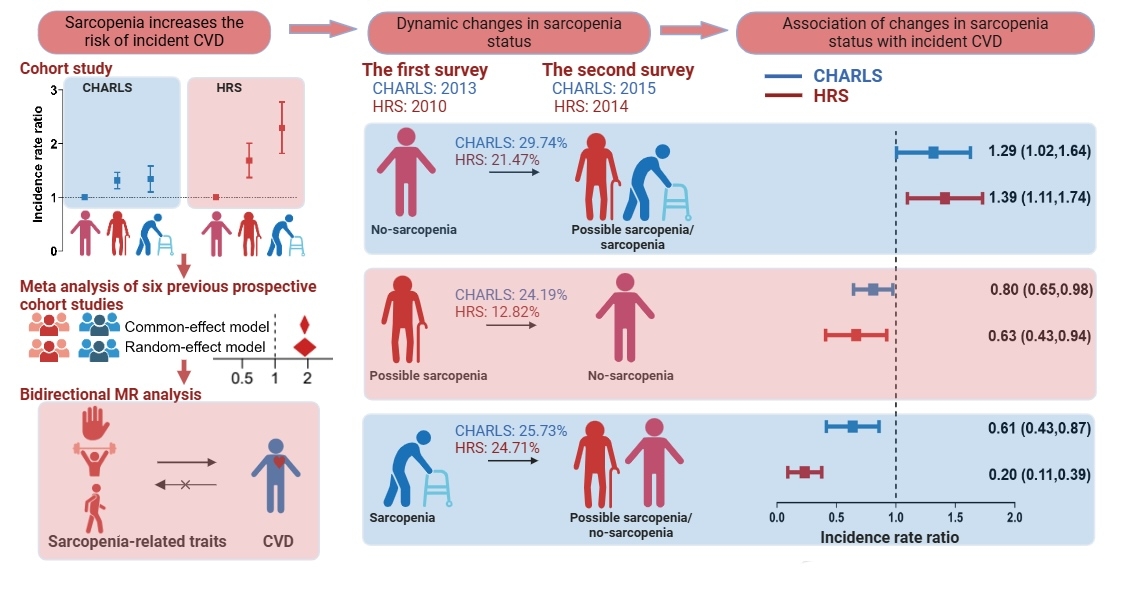Final ID: P3027
Changes in Sarcopenia Status and Risk of Incident Cardiovascular Disease
Abstract Body: Abstract
Background and Aims: Sarcopenia is an emerging risk factor for cardiovascular disease (CVD). However, previous studies did not take into consideration the cardiovascular impact of the dynamic sarcopenia status. We investigated the relationship between changes in sarcopenia status and incident CVD.
Methods: Participants from two prospective cohorts: the China Health and Retirement Longitudinal Study (CHARLS) and the Health and Retirement Study (HRS) were included. Changes in sarcopenia status were assessed by sarcopenia status at the initial two surveys. CVD was ascertained by self-reported physician-diagnosed heart disease or stroke. Robust Poisson regression models were used to estimate the incidence rate ratio (IRR) and 95% confidence interval (95% CI) for incident CVD. We employed two-sample bidirectional Mendelian randomization (MR) analysis and meta-analysis to verify their link.
Results: A total of 6,608 and 4,316 adults from CHARLS (mean age: 59.2 years, female: 53.6%) and HRS (mean age: 63.2 years, female: 60.2%) were analyzed, with a median follow-up of 5.0 years and 7.5 years, respectively. Compared with no-sarcopenia at baseline, possible sarcopenia and sarcopenia were significantly associated with CVD risk. Meta-analysis of the two and previous four cohorts and MR analysis supported the robustness and causality. Compared with stable no-sarcopenia participants, multivariable-adjusted incidence rate ratio (IRR) and 95% confidence interval (95% CI) for incident CVD in those who progressed from no-sarcopenia to sarcopenia/possible sarcopenia were 1.29 (1.02-1.64) and 1.39 (1.11-1.74) in both cohorts. In contrast, sarcopenia participants who recovered to no sarcopenia/possible sarcopenia had lower incidence of CVD (CHARLS, IRR 0.61, 95% CI 0.43-0.87; HRS, IRR 0.20, 95% CI 0.11-0.39) than stable sarcopenia participants did.
Conclusions: The progression of sarcopenia status increases the risk of CVD, while the recovery of sarcopenia status reduces the risk of incident CVD.
Background and Aims: Sarcopenia is an emerging risk factor for cardiovascular disease (CVD). However, previous studies did not take into consideration the cardiovascular impact of the dynamic sarcopenia status. We investigated the relationship between changes in sarcopenia status and incident CVD.
Methods: Participants from two prospective cohorts: the China Health and Retirement Longitudinal Study (CHARLS) and the Health and Retirement Study (HRS) were included. Changes in sarcopenia status were assessed by sarcopenia status at the initial two surveys. CVD was ascertained by self-reported physician-diagnosed heart disease or stroke. Robust Poisson regression models were used to estimate the incidence rate ratio (IRR) and 95% confidence interval (95% CI) for incident CVD. We employed two-sample bidirectional Mendelian randomization (MR) analysis and meta-analysis to verify their link.
Results: A total of 6,608 and 4,316 adults from CHARLS (mean age: 59.2 years, female: 53.6%) and HRS (mean age: 63.2 years, female: 60.2%) were analyzed, with a median follow-up of 5.0 years and 7.5 years, respectively. Compared with no-sarcopenia at baseline, possible sarcopenia and sarcopenia were significantly associated with CVD risk. Meta-analysis of the two and previous four cohorts and MR analysis supported the robustness and causality. Compared with stable no-sarcopenia participants, multivariable-adjusted incidence rate ratio (IRR) and 95% confidence interval (95% CI) for incident CVD in those who progressed from no-sarcopenia to sarcopenia/possible sarcopenia were 1.29 (1.02-1.64) and 1.39 (1.11-1.74) in both cohorts. In contrast, sarcopenia participants who recovered to no sarcopenia/possible sarcopenia had lower incidence of CVD (CHARLS, IRR 0.61, 95% CI 0.43-0.87; HRS, IRR 0.20, 95% CI 0.11-0.39) than stable sarcopenia participants did.
Conclusions: The progression of sarcopenia status increases the risk of CVD, while the recovery of sarcopenia status reduces the risk of incident CVD.
More abstracts on this topic:
Analysis of Near-Infrared Spectroscopy Vascular Occlusion Test as a Complement to Ankle-Brachial Index and 6-Minute Walk Test in Patients Diagnosed with Peripheral Artery Disease
Rodriguez Cesar, Lanka Santh Prakash, Maraj Joshua, Alsabbagh Yaman, Farres Sam, Ade Carl, Liu Xiuwen, Delp Judy
A Novel Animal Model for Pulmonary Hypertension: Lung Endothelial Specific Deletion of Egln1 in MiceLiu Bin, Yi Dan, Ramirez Karina, Fallon Michael, Dai Zhiyu

